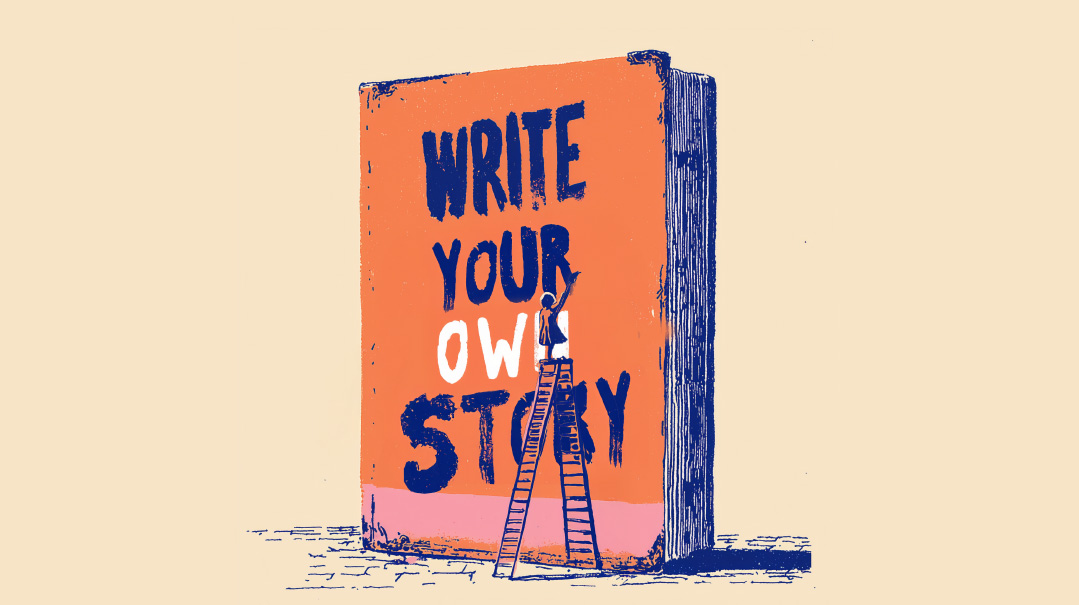Always Room for Improv-Ment

Standup earns a standing ovation on life’s stage

I’ll never forget that late rainy evening at Middle School PTA, sitting across from my daughter’s Chumash teacher. “Your daughter is doing great in school and has friends,” she told me.
Then she uttered a sentence that made me glow with pride: “And even if they bring the class off-topic, I do love her one-liners.”
Ahh. The apex of mommy nachas. My progeny inheriting a sense of humor beats any certificate of academic excellence.
Growing up, I also cracked one-liners in class… except no one heard them because I didn’t say them out loud. In school, I was an introverted people watcher. I didn’t really talk to the peers in my grade, but I wasn’t miserable because I was constantly entertained by the running side commentary in my own head. I once even overheard my teacher telling the principal: “Even when she sits alone in a room, you can hear laughter from inside.”
When I was ten years old, I remember being asked, “What do you want to be when you grow up?” A practical girl, I answered, “A veterinarian.” But my inner voice whispered, “A stand-up comic.”
Fast forward a few years. My veterinarian career choice was abandoned (soon after I realized I’d have to touch kittens with flu and hamsters with gout), as was my dream of being a stand-up comedian (too impractical). I chose instead to be a teacher (does that count as being in the limelight?) and now my captive audience is privy to jokes between lessons on vocabulary and creative writing.
But it wasn’t enough for me — I needed another outlet for the steady stream of humor inside my mind. So I ended up taking a few improv classes. During COVID, I even took one online on Zoom. Finally, I’d found a way to get all my humor out (talk about comic relief).
What exactly is improv? Improvisational theater, as it’s officially known, began in 1963 with a small group of performers who thought it would be fun to create spontaneous scenes with zero prior rehearsal or script. This skill of unprepared acting became a vehicle that spawned some of the greatest comics around.
The improv classes I took taught me far more than how to cull my creativity. They taught me how to navigate our very uncertain lives.
Let’s pause for that serious line.
Awkward silence.
…And I’m back.
How did improv classes create such a crucial skill set for me? Glad you asked. Here are some improv foundations and the tenets of life they taught me.
Yes… And…
The most basic rule of improv is that, wait for it… there really are no set rules. In short form improv, there is usually the audience — or in my case, the course instructor — who will call out a setting and/or situation. For example, a business office with disgruntled workers.
Next, one of the improv performers will set the scene by making an action or a comment, also called an “offer.” A strong offer is clearly creating a basis for the scene, while an ambiguous offer lends itself to having all participants layer their input little by little.
For example, the first performer walks into a space, extends her hands as if presenting something, and says, “Hi, Chaia, I brought you a cake.” That’s called an “ambiguous offer” because Chaia (how cool is this — I’m playing myself in this article!) looks at the invisible cake and must add a comment that will bring the audience into a story that is literally being made up as these two women perform.
So Chaia replies, “Thanks, Suri! How did you know it was my birthday, Boss?” This one short phrase has now established that there’s an employer-employee relationship between Suri and Chaia and that it’s Chaia’s birthday.
Compare that to a “strong offer”: “Happy Birthday, Chaia! I brought you a cake for your 90th birthday!” Now Chaia (it’s me again, isn’t improv fun?) can take it from there: “Thanks, Suri, but with my dentures, I prefer applesauce.” At that point, the instructor will end the dialogue by saying “and scene.”
Now imagine if, in this scene, I responded to Suri with, “That’s not a cake, and my name isn’t Chaia.” The scene would be dead. The job of each performer is to build on the other’s additions to the scene, through what’s known as the “Yes… And…” rule.
For this rule, the “yes” part means that whenever your improv partner says a comment (which ends up navigating the scene), you always accept the “offer.” In this case, I accepted that Suri’s hands were holding an invisible cake, that the cake was for me, and that my name was Chaia.
The “and” part of the rule means that you must build the scene with your reply. In the above example, my reply established that it’s my birthday, my improv partner’s name is Suri, and she’s my boss.
What It’s Taught Me:
Following the “Yes… And…” rule ingrains in you that, in any given situation, there are an infinite number of ways to respond. I understood this concept intuitively. I’m a writer and was a bonafide space cadet growing up — I lived (still live?) in a fantastical land where anything is possible: you can breed horses with rainbow hair and a calorie-less cookie can be invented.
But practicing the concept of “Yes…. And…” repeatedly in class — and having it pounded into my head by the course instructors — trained me to pause before responding. Since I had to say “yes” to my partner’s offer, how could I respond in a way that would make sense based on the truths laid out in front of me? Instead of jumping to an instinctive response, I had to be patient and wait for an appropriate response to come.
This skill has bled into my everyday interactions. Recently, when a student turned in an opinion essay and argued that it fit the requirements for his personal narrative assignment, I was able to say with a smile, “Yes, Baruch, a personal narrative can be an opinion essay, as long as the opinion is illustrated in a first-person narrative story that happened to you.” I accepted his truth… and added my own.
Imagine a fellow mom adding her two cents to a group of ideas on how to run the Purim chagigah. Instead of the party organizer saying, “Raizel, I’m not so sure that real circus clowns would be good for a timid group of preschoolers,” imagine if she’d respond, “Yes, clowns! They add so much energy. How can we add that vibe to the event in a way the kids would fully enjoy it? Let’s consider that as we add that theme idea to our list — maybe it can be for the decor.”
Notice that “Yes… And…” is about considering. And considering doesn’t mean one has to agree fully, just that you can build on it.
“Yes… And…” is such a powerful skill that corporate businesses sometimes bring in improv teams to lead workshops on brainstorming and team building. I’ve been in meetings where the participants are not “Yes… And…” aware. I once offered an idea on how to create a new document for an educational program and was shot down with, “No, that won’t work” by the meeting head. Guess how many people had the guts to offer ideas after that comment?
Understand Your Role in the Scene
Committing to the identity of the character your improv partner created for you is crucial. In the above example, whether I liked it or not, I was now a 90-year-old birthday girl. If I didn’t accept my role, chaos would ensue. (Fun fact: my phone always autocorrects Chaia to chaos. My phone really is intuitive.)
Isn’t the whole idea of making up a scene as you go along a bit, shall we say, nutty? Yes, dear reader… And (see how I snuck it in) while there is an improv concept called Crazy Town — when everything in the scene has gone too weird too quickly and there is nobody reacting realistically to anything — it’s still more fun than a boring scene. But for beginners, balance and variety is best. A scene and your role should be relatable to some degree.
I once had a scene with a young woman and she started first (also known as “went out”) by saying, “Did you hear that Mr. Jones gave me a promotion?!” I was a bit bummed to be playing the passed-over worker, but I went with it. Mimicking a typing stance, I looked over at her in shock. “He did? But you’ve only been working here for three weeks!” To which she added, “Yes, but I guess he liked my work.” I finished off the scene by stomping toward the boss’s imaginary office, wailing, “Daddy, no fair!” I knew my role, so I was able to support hers and have fun with mine.
What It’s Taught Me:
Okay, I admit it, I still don’t always know my role on the stage of life. When my kid comes home complaining about a problem with a teacher, my Ima Advocate Antennae perk up and I want to come to the rescue. But maybe my job here is to help him self-advocate and solve his own problems instead? I think I deserve points for at least trying to understand my role in the situation.
Same goes for all the relationships in my life. Recently, a friend was complaining to me because she promised to make dinner for a meal train and was too overwhelmed to do it. I aim to be Superwoman, so I was itching to just make the spaghetti and meatballs for her, but then I remembered all the other (more important) roles assigned to me at that moment and switched from “savior” to “empathizing friend.”
Listen and Stay in the Moment
I’m on stage, about to start a scene. The course instructor calls out the setting and the occupation of my improv partner: a hospital maternity ward and a dog trainer. My partner, Rechy, comes out first and says, “I can’t wait to see the litter!”
Now where do I go with this? That all depends on what kind of details I’ve picked up. For instance, did Rechy use a sarcastic tone? Is she holding an imagined pet carrier and referring to the litter of puppies inside? Or is she referring to an imaginary patient in the maternity ward who just gave birth to quadruplets? Or, I wonder, is Rechy using the word “litter” as in “trash” and referring to the mess in the hospital halls?
To build up a scene properly, improvers are trained to pay attention to anything and everything. Did the performer stutter when she spoke? Did she limp? Is her head cocked to the side for some reason? You’re not only listening with your ears but with your eyes: the slightest irregularity in speech or action can be significant.
Rookie improvers are usually more focused on what they are going to say instead of what their improv partner is saying. So they end up contradicting their partner or confusing the audience (or both).
For example, going back to the original cake scene, let’s say my boss, Suri, gives me a cake and I reply, “How did you remember that today is 30 years since I married your father?” That would leave the audience scratching their heads: Huh? Is she an employee with a birthday or a parent with an anniversary? You have to listen, really listen, to what details are being unpacked in the scene.
What It’s Taught Me:
I used to think I was a good listener (except when I was spacing out in class). But what I learned from improv is how much you can learn from what they aren’t saying. If a loved one (or a not-so-loved one) is leaving out certain details, why are they doing that? I’m likewise far more tuned in to all the nonverbal communication: their body language, tone, facial expressions, and so on.
I’m not saying that improv taught me to read into things too much (I do that naturally, I have many superpowers) but that it’s helped me to see the whole picture.
When someone is sharing a struggle, I try to listen to how they are experiencing it instead of processing the information through the prism of my past experiences and similar struggles. This way, I don’t jump to conclusions and can give them advice or a message of support based on what they need. Sometimes, I’m able to see that what they really want is simply for someone to hold space for their current experience.
Remember the famous story of the man who asked a rav if he could drink milk for the Arba Kosos at the Seder? The rav didn’t just hear a man who wanted the rav’s erudition. He heard a man who couldn’t afford wine or meat. His empathetic listening is a lesson for me every day to not make things about me.
Step Up
You’re on stage now and the course instructor calls out a topic: Squirrels and presidents.
Freeze.
Don’t read ahead.
If you “went out” on stage first, what would you say? How would you associate these two ridiculously random subjects?
As an improv player, you can either keep silent, or say “yes” and jump into the scene by… ta-da… stepping up. Just say something, anything!
“Hey guys, did you hear about the new Toyota Squirrel? Runs faster than a toddler on caffeine and has a trunk to hold your luggage and acorns.”
Your partner replies, “I hear there are some amazing President Day sales at the dealership downtown. I’ll be driving in my new lime-green Squirrel in no time.”
Wacky, sure. Improvisational, uh-huh. There are no parameters in a scene, so be the one to step up and offer whatever words come to mind.
By opening the scene with something, you open the minds of your fellow improvisers. Then they can catch on and share other unexpected offerings. Be a fearless leader and an even more fearless follower.
What It’s Taught Me:
This is straight from the annals of U’vemakaom she’ein ish, hishtadeil liheyos ish — in a place where there is no man, be the man (or woman, in my case.)
On our group chat for school, there’s always that one person who lets everyone know “Morah’s daughter just got engaged!” Typically, that’s followed by a steady stream of posts — “mazel tov!” and “great news!” — and then total silence.
Who is going to offer to organize a class gift for Morah’s new kallah?
Step up, my friends. Especially today, where sending money is easier than ever, be the one who takes the time to rally the troops and do right by your teacher, principal, neighbor, friend, whomever. Step up and offer to create a meal train for someone (it always comes back to the meal train doesn’t it…).
In improv, you always support your partner. So if someone else already stepped up to collect money for a gift, shivah tray, or the like, contribute right away and then offer ideas of where to get good gifts, or encourage those who might not have Zelle and say you’ll front the money until they pay you back.
Being fearless and being a leader is what propels kindness in the world.
Failure Is Success
The first time I was called up for an improv scene in class, I was terrified. It’s hard enough giving a speech or a shiur when you have notes in front of you and previous speaking experiences to rely on. But now you’ve got to wing it — in front of an audience of aspiring improvers — without knowing what your fellow performer will say or do.
To top it off, you’re flooded with every type of teenage insecurity: What if I don’t fit in, or can’t figure out “what’s done,” or don’t say the right thing? Then there are the practical fears: What if I say something and my partner has no idea what I mean? What if I freeze up and can’t think of anything to say?
The beauty of doing improv is that your partners always have your back (I wish I could say the same of classmates) and most of your epic failures will bring epic laughs. Improv is not about who can be the funniest or wittiest or most prepared. There are tons of laughs, but it’s usually because of the absurdity of realizing we really have no idea what comment or situation is around the corner.
Some of my best scenes were created by mess-ups. I once misunderstood my Gen Z partner’s slang: when she told me to “spill the tea,” I mimed getting a teapot and pouring it into the cup and then pouring it from my cup onto my lap. The audience erupted into laughter. How was I supposed to know that the expression “spill the tea” means “share the gossip”? An error on so many levels. But also hysterically funny.
What It’s Taught Me:
Some of my greatest moments of personal growth have come from learning from my mistakes. And I’ve had lots of experience with mistakes. If you can count your parenting bloopers on one hand, you’re clearly not human. I’ve made my fair share of them, and I used to berate myself endlessly afterward.
Ditto for technical errors. In my fruit platter business, there are lots of gears to make the system run. Read: There are lots of opportunities to make errors… and I have. Like when I entered a customer’s order incorrectly into the computer, or worse, forgot to enter any order at all. (Nothing sends my heart pumping like an Erev Shabbos call from an unfamiliar number.)
Instead of my old habit of self-flagellation, now I do my hishtadlus to correct the mistake and then remind myself that I am just a simple person. Failure is part and parcel of this condition called humanity.
What I’ve learned from doing on-the-fly scenes in improv is that anything that I do — any ideas that enter my head and any reactions that play out as a result — are part of a Master Plan by Hashem, Who is the best at sending unexpected scenes my way.
Though I can’t control what comes at me, I can control how I react — whether the scene is playing out on stage, or in my life. It comes down to this (warning, serious line coming up): Improv has taught me that failure is only a failure if you don’t learn from it.
Here’s another saying I should coin (patent lawyers are standing by): Improv your life so you can improve your life. Anything is possible if you just trust the process.
And Scene.
(Originally featured in Family First, Issue 833)
Oops! We could not locate your form.







